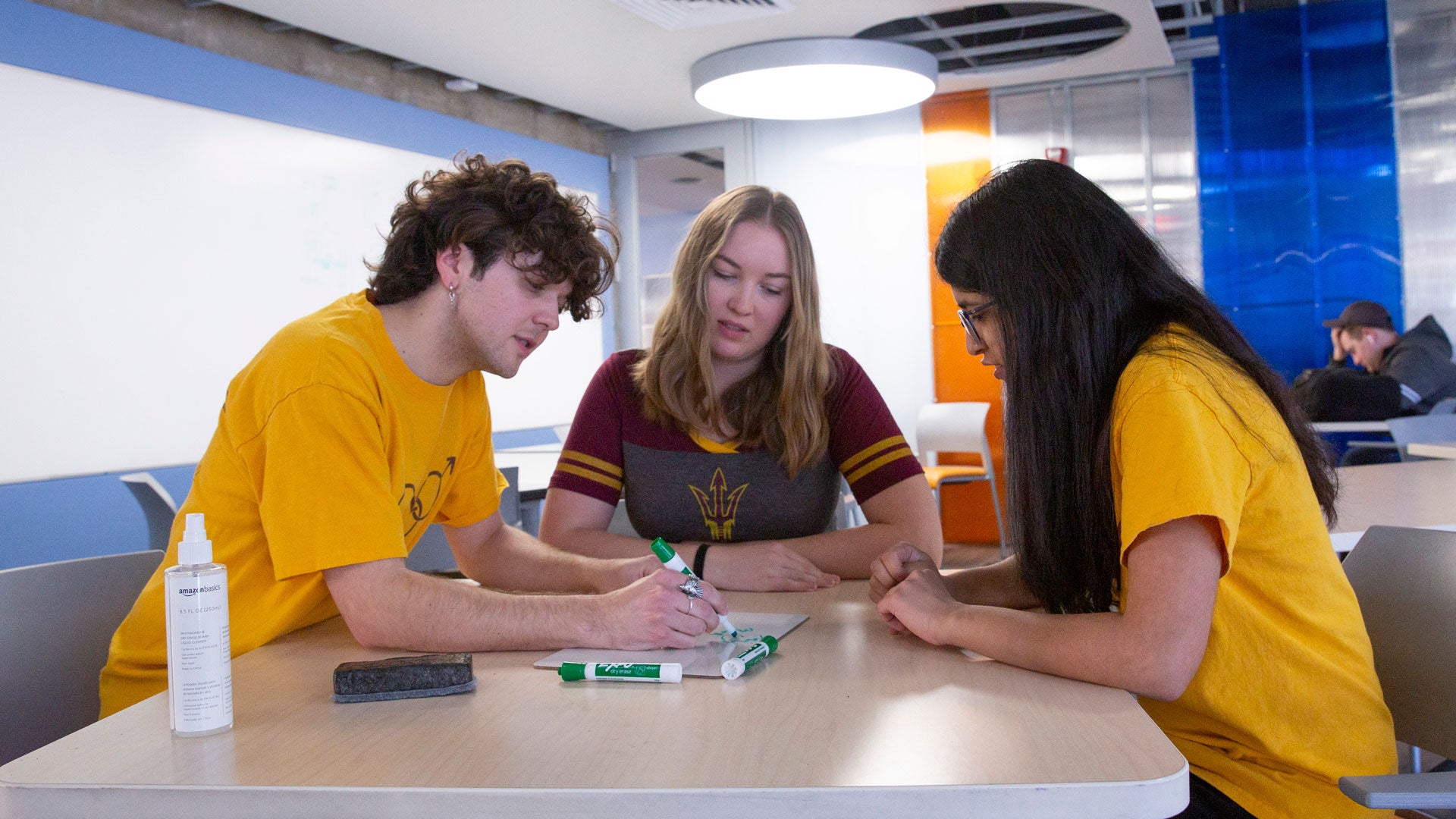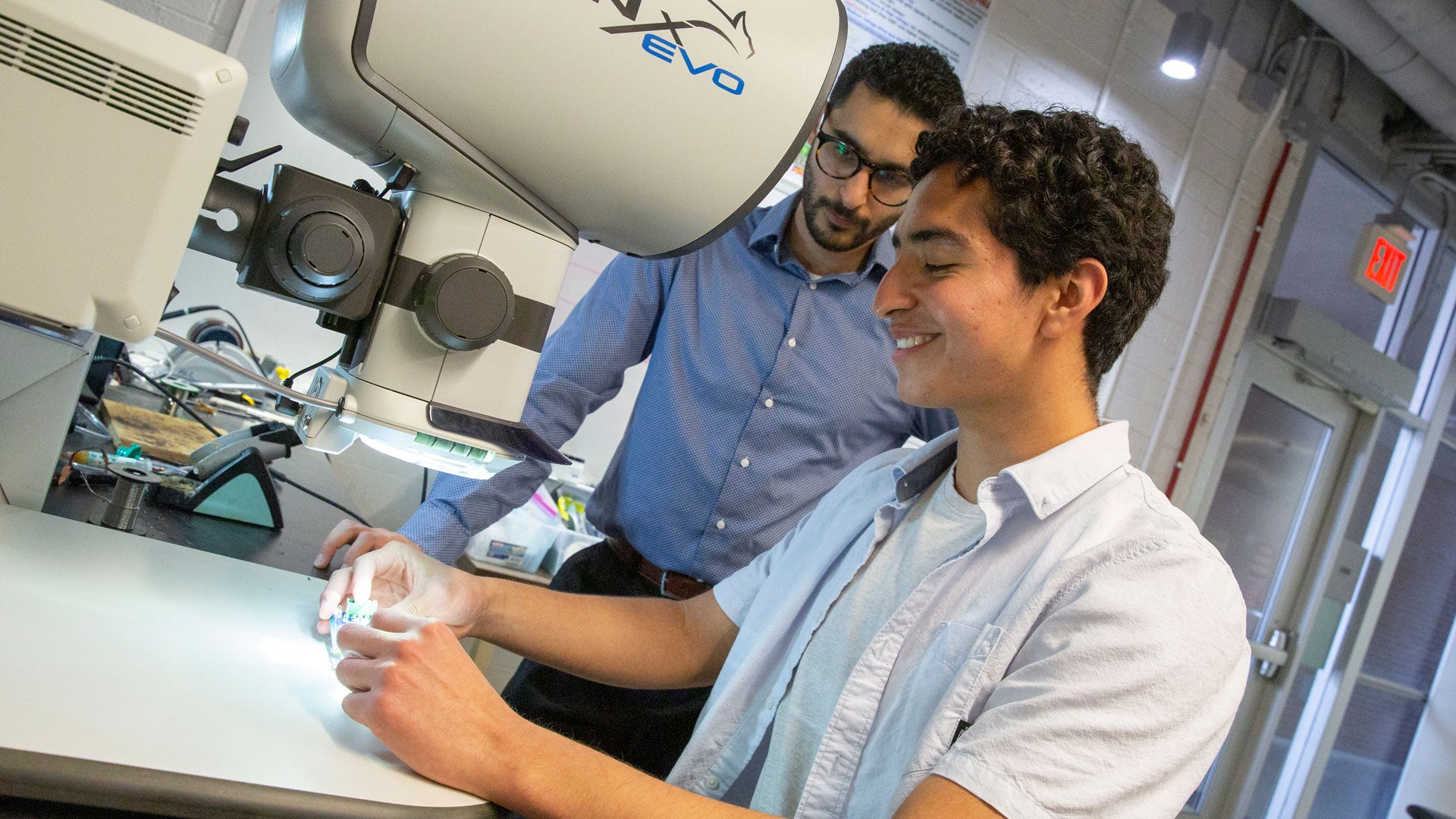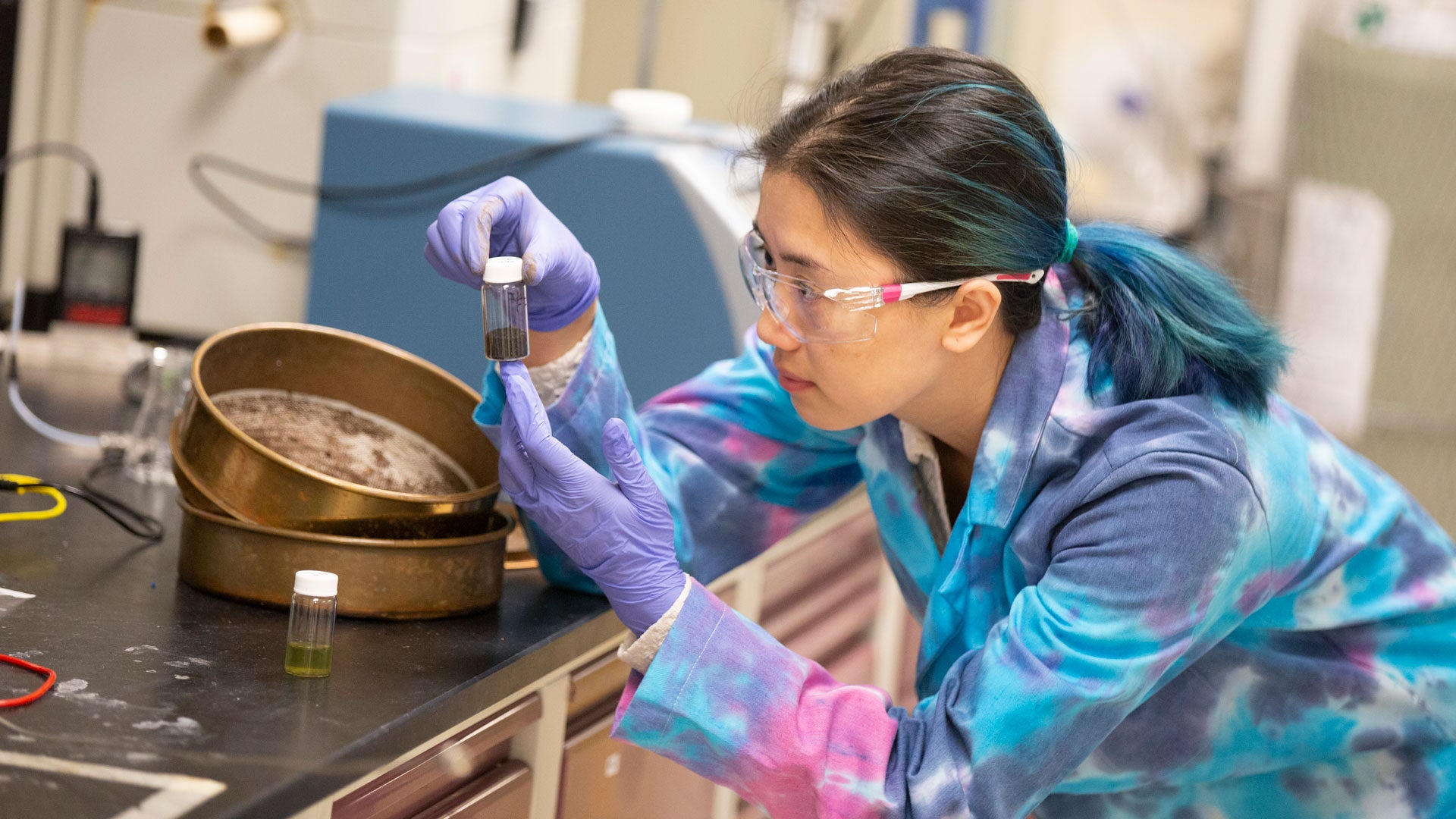Meet student researchers making real-world impact

Arizona State University chemical engineering major Kelly Nguyen studies how microplastics in combination with pesticides affect soil contamination as part of a research project with the Fulton Undergraduate Research Initiative. Nguyen is one of many student researchers in the Ira A. Fulton Schools of Engineering helping to solve real-world problems through hands-on research. Photo by Erika Gronek/ASU
Exploring brain-inspired computing, investigating the impact of teaching techniques on mental well-being, making data centers more efficient, and studying the effects of microplastics and pesticides on soil are just some of the ways Arizona State University students are solving real-world problems through hands-on research.
Students in the Ira A. Fulton Schools of Engineering can apply their classroom knowledge in a range of research pursuits. Their work delivers innovation that matters for challenges in data science, education, energy, health, security, semiconductor manufacturing and sustainability.
The Fulton Undergraduate Research Initiative, or FURI, and the Master’s Opportunity for Research in Engineering, or MORE, programs give students valuable experiences in which they spend a semester conceptualizing an idea, developing a plan and investigating their research question with a faculty mentor.
Students in the Grand Challenges Scholars Program, or GCSP, have the option to conduct research as part of the program’s rigorous competency requirements that prepare them to solve complex global societal challenges.
These three programs enhance students’ ability to innovate, think independently and solve problems in their communities. They also benefit from the technical and soft skills they gain, which prepare them for their careers and pursuit of advanced degrees.
Twice per year, students who participate in FURI, MORE and GCSP are invited to present their research findings at the FURI Symposium. Learn about four Fulton Schools students and more than 100 other student investigators participating in the spring 2023 FURI Symposium, which is open to the public on Friday, April 21, 1–3 p.m. at the Sun Devil Fitness Complex on the Tempe campus.
A look at some of the projects
Hailey Warner and Priyanka Ravindran
Electrical engineering majors Hailey Warner and Priyanka Ravindran are working on individual research projects in the FURI program that explore memristors, an electrical component of future microelectronics that has both memory and the ability to process data. These projects, mentored by Ivan Sanchez Esqueda, an assistant professor of electrical engineering, are among the first in a new semiconductor manufacturing research theme represented at the FURI Symposium. They are also sponsored by semiconductor foundry company TSMC. This new opportunity provides a way for the global leader in the semiconductor foundry business to support ASU students conducting exceptional research on semiconductors.
Warner’s research explores the physics of 2D hexagonal boride nitride memristors, which are computing components made of a conductive ceramic material. These devices could be used in future neuromorphic, or “brain-inspired,” computing and improve machine learning hardware and neural networks.
Ravindran seeks to improve machine learning through hardware in her FURI project by investigating the stacked layers of 2D materials present in neuromorphic computing devices. She hopes to further the effort of increasing computational efficiency in modern-day technology.
Hailey Warner (left), an electrical engineering junior, and Priyanka Ravindran (right), an electrical engineering senior, work on semiconductor-related research projects in the FURI program under the mentorship of Ivan Sanchez Esqueda (middle), an assistant professor of electrical engineering. Photo by Erika Gronek/ASU
Question: What made you want to get involved in FURI and this particular research subject?
Warner: I first discovered Professor Ivan Sanchez Esqueda’s research in memristors via the FURI webpage nearly two years ago. I became fascinated with this burgeoning field of neuromorphic computing and knew I wanted to one day to participate in FURI for a chance to deepen my knowledge in a field beyond what classes could teach me.
After completing an electronic materials course and an internship at Intel, I reconnected with Sanchez Esqueda, and he was very welcoming and excited to bring me into his lab.
Ravindran: As a third-year electrical engineering student, I took interest in circuit design and hardware development, which inspired me to find a project that contained these interests. I came across Professor Ivan Sanchez Esqueda’s page on the FURI website and became interested in his lab’s vision and work in neuromorphic computing.
I chose this project for the chance to explore the hardware side of neural networks, a field that I had been doing surface-level readings about in scholarly journals and online articles.
This project is based on integrating two powerful devices into one circuit, which involves applying the fundamentals that I have acquired in my courses to analyze the overall behavior of the devices in circuits.
Q: How will your research project impact the world?
Warner: Neuromorphic computing revolutionizes how we view computer architecture by embedding memory within the processing unit, just like the human brain. The devices that make this possible? Memristors!
Think of memristors like a neuron. Not only can they store information, but when arranged together in certain ways, they can perform impressive computations with extreme haste and efficiency.
Memristors are an incredibly promising technology but they need to become more reliable. Through carefully testing and modeling these devices’ behavior, we can refine the manufacturing process and embed them in increasingly complex systems.
Ravindran: Neuromorphic computing involves larger quantities of data that are being parallelly processed and placed into memory locations. There is no single processing unit or memory location in the brain. If a computer could mimic the brain’s computational ability, it would be able to perform complex computations with much-improved efficiency.
Q: How do you see this experience helping with your career or advanced degree goals?
Warner: Whether in industry research and development or academia, my goals have been set on research and scientific pursuit for quite a while. FURI exposes students to what this world is like. I hope to take both the technical, specific knowledge along with the soft skills I’ve acquired through FURI into graduate school and beyond.
Ravindran: Hardware design and development is a field that I have always been able to see myself in. Pursuing research has really inspired me to gravitate toward a graduate degree in electrical engineering and establish a career in the ever-growing semiconductor manufacturing industry. Contributing to the advancement of new semiconductor devices and discovering their capabilities is something I would take great pride in being a part of. Research in particular comes with plenty of freedom as there is space to make mistakes and learn. My aptitude to learn quickly has developed while pursuing research and will continue to improve in graduate studies and industry. I am thankful for getting the opportunity to assist in this particular research within academia as it has inspired me to take my education to new heights and acquire significant skills I can apply in the future.
Daniella Pautz
Biomedical engineering graduate student Daniella Pautz is exploring how engineering professors can use persuasion methods to help students succeed in class and improve their mental well-being. Her MORE research with faculty mentor Claire Honeycutt, an assistant professor of biomedical engineering, seeks to address the high rates of depression and anxiety among engineering students and help them succeed in this difficult field of study.
Daniella Pautz (center), a biomedical engineering graduate student, works with FURI students Maxwell Johnson (left) and Ruhi Dharan. Pautz’s research explores how methods of persuasion used by engineering professors can affect students’ performance and well-being. Photo by Erika Gronek/ASU
Q: What made you want to get involved in MORE, and why did you choose the project you’re working on?
Pautz: I have always had a passion for engineering, but I've also always had a passion for teaching and learning. I was talking with my faculty mentor about what I wanted to do for my thesis and mentioned that one day I wanted to teach. She suggested studying teaching methods in engineering education in order to combine my interests. So, we brainstormed and came up with the idea of studying persuasion techniques and how they are used in the classroom.
Q: How will your research project impact the world?
Pautz: I believe my research can change the way teachers and professors interact with their students across all disciplines. Having a positive relationship with students can enhance their learning and help improve their mental health. With the mental health crisis growing across the world, interventions are necessary, and this can start in the classroom.
Q: Have there been any surprises in your research?
Pautz: I was surprised to see that teachers who are strict and use rules and punishments in their classes actually have a negative impact on student academic outcomes as well as student mental health. Many strict professors believe that it is their job to teach students how to be obedient, especially at younger ages, and that if they don't force students to participate, they won't. It turns out this belief harms students’ outcomes, decreases their engagement and increases their stress.
Learn more about Daniella Pautz’s Spring 2023 MORE project.
Humberto Delgado
Humberto Delgado is an electrical engineering junior conducting research in the FURI program. With his mentor, Mike Ranjram, an assistant professor of electrical engineering, he is working on a solution to address the size and power requirements of power supplies that provide the energy for data centers. As our online presence continues to grow, miniaturizing power electronics and making them more efficient can better meet the energy needs of data centers more sustainably.
Electrical engineering junior Humberto Delgado (foreground) works with Mike Ranjram (background), an assistant professor of electrical engineering, on a FURI project to miniaturize power electronics to make data centers more energy efficient. Photo by Erika Gronek/ASU
Q: What made you want to get involved in FURI? Why did you choose the project you’re working on?
Delgado: I wanted to get more hands-on experience while being able to complete a project I am passionate about. I chose my project because this is a big step in the overall miniaturization of power electronics, which can mean more energy-dense power supplies.
Q: How will your research project impact the world?
Delgado: I hope this project can impact the world by showing how small power converters can get using Professor Ranjram’s new transformer layout. Hopefully this will open the doors to research in optimizing power electronics, especially as we face a new era with large amounts of renewable energy.
Q: Have there been any surprises in your research?
Delgado: I am a first-time researcher, and I have had to redo things to try to perfect a task, but this has helped me learn and develop problem-solving and design skills.
Learn more about Humberto Delgado’s spring 2023 FURI project.
Kelly Nguyen
Kelly Nguyen is a chemical engineering junior researching how microplastics in combination with pesticides affect soil contamination. This FURI project under the mentorship of Shuguang Deng, a professor of chemical engineering, provides new information about the environmental impact of microplastics and how humanity can more sustainably interact with the environment in the future.
Chemical engineering junior Kelly Nguyen investigates how microplastics and pesticides affect soil contamination as part of a FURI research project with Shuguang Deng, a professor of chemical engineering. Photo by Erika Gronek/ASU
Q: Why did you choose the project you’re working on?
Nguyen: I chose to do my project on the interaction of microplastic and pesticides in soil because of my interest in sustainable polymers, also known as plastics. Microplastics are a big issue in the world of sustainability, and understanding the effects that they have in interacting with the environment will only further innovation in developing polymers that are better in the long run.
Q: How will your research project impact the world?
Nguyen: With the increasing concern about microplastics in soil, there is a need for more in-depth research to fully understand the relationship between pollutants and microplastics in a terrestrial environment. The results that come from this research will only further our understanding of the interactions between microplastics and soil contamination.
Q: Have there been any surprises in your research?
Nguyen: The biggest surprise in my research was the shift from my original experimental plan to my current one. I shifted to doing hydrothermal liquefaction of soil, pesticide and microplastics instead of measuring the amount of pesticide that the soil adsorbed over a period of time.
Q: How do you see this experience helping with your career or advanced degree goals?
Nguyen: One of my career goals is to run a lab researching more sustainable, highly accessible polymers. The experience of working in a lab setting allows me to learn the intricacies of being in a lab and how it can run so smoothly with many different working parts.
More Science and technology

ASU to host 2 new 51 Pegasi b Fellows, cementing leadership in exoplanet research
Arizona State University continues its rapid rise in planetary astronomy, welcoming two new 51 Pegasi b Fellows to its exoplanet…

ASU students win big at homeland security design challenge
By Cynthia GerberArizona State University students took home five prizes — including two first-place victories — from this year’s…

Swarm science: Oral bacteria move in waves to spread and survive
Swarming behaviors appear everywhere in nature — from schools of fish darting in synchrony to locusts sweeping across landscapes…





